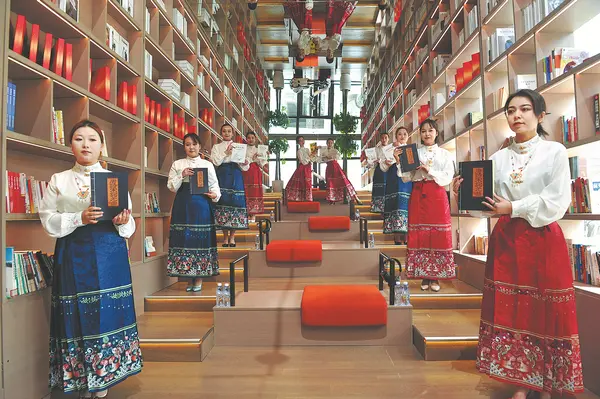If you ask Generation Z — those born after 1995 and in the 2000s — what the current fashion craze in China is, "new Chinese style" will likely be the answer. After gaining immense popularity during this year's Spring Festival in February, the organic blend of traditional Chinese aesthetics and modern style continues to charm hearts during spring and summer, becoming a buzzword in the domestic consumer market.
New Chinese-style clothing is typically defined as seamlessly integrating traditional Chinese elements with contemporary styles. It not only encapsulates traditional aesthetics and cultural heritage but also fuses materials, techniques and technologies stemming from modern science.
On social media platforms like Douyin and Xiaohongshu, the "new Chinese style" remains a fervent topic. E-commerce data from short video platform Kuaishou showed that in the first quarter of this year, orders for products of "new Chinese style "increased by 700 percent compared to the same period last year, while orders for hanfu, the traditional attire of the Han ethnic group, increased by nearly 300 percent.
"Our orders are booked six months in advance, with a compound annual growth rate of over 100 percent in revenue," says Lin Qi, inheritor of the craftsmanship for making mamianqun, horse-face skirts, and the founder of a clothing brand. The horse-face skirt is a type of hanfu, featuring a high, flat front and pleated sides that originated in the Song Dynasty (960-1279) and prevailed in the Ming (1368-1644) and Qing (1644-1911) dynasties.
In 2016, Lin started creating unique horse-face skirts, initially selling only a dozen pieces in a year. In just a few years, the annual sales volume of horse-face skirts her company made has soared to an impressive 100,000 pieces. Reflecting on this remarkable growth, Lin says, "The market has undergone notable changes." Currently, a significant portion of her clientele is from the younger generation.
Many of those born post-95 say the inherent beauty of the new Chinese-style fashion touches their cultural genes when asked about its appeal. In addition, what excites young people are the stunning designs that exude a stronger sense of style and contemporary vibes.
A closer look at the prevailing trends of the "new Chinese style "reveals a captivating blend of trendiness and refinement. Whether it's the exquisitely crafted button designs or the artistry in the embroidery embodying intangible cultural heritage, this fusion always perfectly captures young individuals' aesthetic preferences when seamlessly integrating with contemporary clothing styles and silhouettes.
For example, the horse-face skirt has evolved into a more diverse fashion item and has thus gained even greater versatility. To cater to different occasions, it now comes in various lengths, from full-length to midi- and knee-length. To meet the demands of various seasons, the fabric has also seen improvements, transitioning from thick wool knits to lightweight cotton, linen and silk.
From the qipao — a traditional Chinese dress for women — to hanfu, almost every popular fashion item is a reinterpretation of tradition. "We have invested a significant amount of time and money in collecting hundreds of traditional Song brocade patterns, studying weaving techniques and innovating to make them more in line with the modern aesthetics," says Wu Jianhua, president of a silk research and development company in Suzhou, Jiangsu province.
Wu's company also researched and developed elastic Song brocade, aiming to enhance the fabric's wrinkle resistance, color vibrancy and comfort to make it more suitable for modern wear.
Xue Yadi, born in 2000, praises the "new Chinese style" clothing as "not merely visually appealing but also lightweight". She adds: "Wearing these clothes fills me with a sense of pride."
"The popularity of traditional clothing is closely related to the growing interest in traditional culture. Consumers not only pay for the clothing itself but also appreciate the aesthetic significance and cultural value it carries. This phenomenon reflects a strong cultural confidence among the public," says Yang Xiaodong, vice-president of the China National Garment Association.
XINHUA
CHINA DAILY
 简体中文
简体中文




